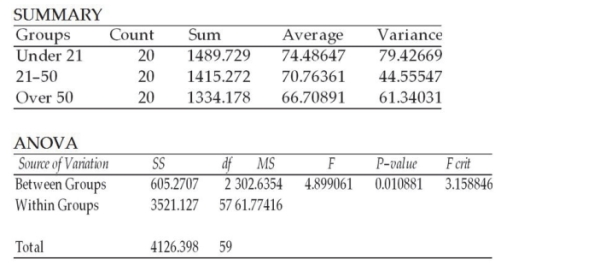As a step in establishing its rates, an automobile insurance company is interested in determining whether there is a difference in the mean highway speeds that drivers of different age groups drive. To help answer this question, it has selected a random sample of drivers in three age categories: under 21, 21-50, and over 50. The engineers then recorded the drivers' speeds at a designated point on a highway in the state. The subjects were unaware that their speed was being recorded. The following one-way ANOVA output was generated from the sample data. Based upon this output, if the significance level is 0.05, the engineers should conclude that the mean speeds may all be equal since the p-value is less than alpha. ANOVA: Single Factor 
Definitions:
Equilibrium Price
The cost at which the amount of a good consumers want to buy matches the amount producers are willing to sell, achieving a state of equilibrium in the market.
Allocative Efficiency
A state of the economy in which production is in line with consumer preferences; every good or service is produced up to the point where the last unit provides a benefit to consumers equal to the cost of producing it.
Production Methods
Various techniques and processes used to create goods and services.
Allocative Efficiency
A state of the economy in which production represents consumer preferences; specifically, every good or service is produced up to the point where the last unit provides a marginal benefit to society equal to the marginal cost of producing it.
Q7: Six food critics each visited and rated
Q10: Determine the 90% confidence interval estimate for
Q34: A major issue facing many states is
Q49: Applebee's International, Inc., is a U.S. company
Q51: In conducting multiple regression analysis, t-tests are
Q52: An advertising company wishes to estimate the
Q102: A start-up cell phone applications company is
Q104: Most companies that make golf balls and
Q136: A study was conducted to determine if
Q151: If the p value is less than